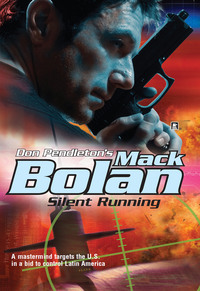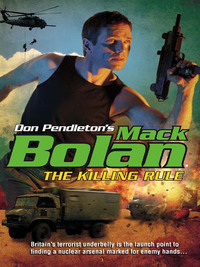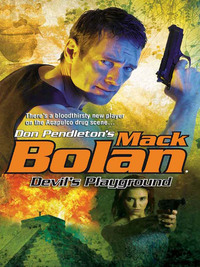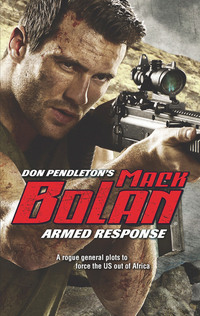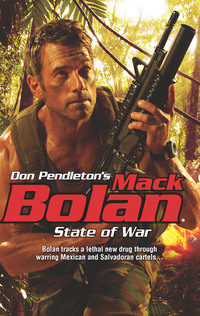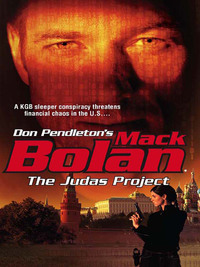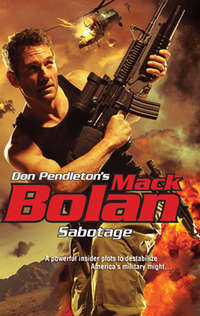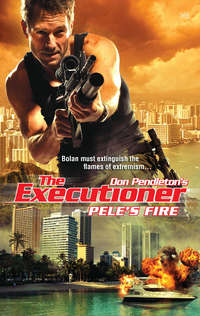
Полная версия
Sabotage

“It is my hope that we as a nation can work through this.”
Trofimov was somber. “But I will not lie to you. It will be difficult. We will have to make some hard decisions about our standing in the world. We will have to come to terms with the barbarism that lurks, even now, within our armed forces. This will not sit well with many of us, but I know we are up to the challenge. For TBT News, this is Yuri Trofimov.”
Schrader switched off the miniset in disgust. “Can you believe that?”
“What happened?” Bolan asked.
“They’re reporting that a bunch of our guys attacked a village in Afghanistan,” Schrader said, “totally unprovoked. Burned the place to the ground. Shot women and children, and the news report says TBT has a videotape with our guys doing it and laughing about it.”
Bolan’s jaw clenched. Things were getting ugly. And they were about to get uglier.
Sabotage
Mack Bolan®
Don Pendleton

www.mirabooks.co.uk
If you know the enemy and know yourself you need not fear the results of a hundred battles.
—Sun Tzu
The enemy doesn’t play by the rules. He will ruthlessly commit murder and a hundred other crimes. The enemy won’t stop, doesn’t feel pity and never feels shame. The enemy has to be engaged, and overwhelmed with superior force. That’s where I come in. That’s what I do.
—Mack Bolan
CONTENTS
CHAPTER ONE
CHAPTER TWO
CHAPTER THREE
CHAPTER FOUR
CHAPTER FIVE
CHAPTER SIX
CHAPTER SEVEN
CHAPTER EIGHT
CHAPTER NINE
CHAPTER TEN
CHAPTER ELEVEN
CHAPTER TWELVE
CHAPTER THIRTEEN
CHAPTER FOURTEEN
CHAPTER FIFTEEN
CHAPTER SIXTEEN
CHAPTER SEVENTEEN
CHAPTER EIGHTEEN
CHAPTER NINETEEN
CHAPTER TWENTY
CHAPTER TWENTY-ONE
CHAPTER TWENTY-TWO
CHAPTER TWENTY-THREE
CHAPTER TWENTY-FOUR
EPILOGUE
CHAPTER ONE
The graveside service was drawing to a close. Family members paid their respects in turns, filing past the casket as it sat poised on its winch straps. Even for a funeral, the mood was grim; the body language of the mourners was tense, brittle with anticipation. That much was obvious as Mack Bolan, the man known to some as the Executioner, watched through a pair of compact Zeiss binoculars. He knelt on a hill in an older part of the cemetery, surrounded by grave markers that were, in some cases, almost a century old. Partially hidden behind a gnarled weeping willow that stood, incongruously, among the oldest of the tombstones, Bolan monitored the narrow, paved access road leading through the cemetery and past the temporary awning sheltering the mourners below.
The soldier checked his watch. If intel from Brognola and Stony Man Farm panned out, it could happen any minute now.
He didn’t need to check the weapons he carried; they were as much part of him as his hands, after so many missions. The custom-tuned and suppressed Beretta 93-R pistol was holstered in its customary place under his left arm. The massive .44 Magnum Desert Eagle rode in a holster on his right hip. Across his chest, he wore an olive-drab canvas war bag on its shoulder strap, over the close-fitting combat blacksuit. His pants were tucked into well-worn combat boots. His battle gear, including a Boker Applegate combat dagger clipped in a Kydex sheath in the appendix position, was concealed under his black M-65 field jacket. On the ground near his right knee, a Pelican case waited, the customized Remington 700 rifle inside another work of art by Stony Man Farm’s armorer.
Mack Bolan knelt, watched and waited, a black-clad and silent wraith watching over the final resting place of so many Americans.
The Executioner reflected upon what had brought him to this place. The scrambled phone call from Brognola had left a taste like ashes in his mouth.
“Someone,” the man from Justice had said, calling from his office in Washington, “is killing our soldiers.”
“I’m listening.”
“We thought, at first, that it was random,” Brognola went on. “Murders occur, of course. It stands to reason that some of them would affect returning servicemen and-women. But Aaron takes a special interest in veterans, especially wounded vets, and he started flagging the news reports in a database in the Farm’s computers.”
“Understood.” Bolan nodded, unseen by the big Fed on the other end. “Aaron” was Aaron “the Bear” Kurtzman, head of the Farm’s cybernetics team and a wizard with computers of all types. If it existed in the ether, if it could be located within a network somewhere on the planet, Kurtzman could find it. The computer expert was confined to a wheelchair, the result of an ill-fated attack on the Farm some years before.
“What began to emerge,” Brognola said, “was a disturbing pattern. Aaron’s computers pulled up report after report of murders across the country—involving a returning veteran of combat in Iraq or Afghanistan. Six men, three women. In two of these cases, the reports included similar crime-scene evidence, including cryptic notes about ‘peace’ and ‘love’ and ‘ending barbarous imperialism.’ When we dug further, we found that it wasn’t just those two. These notes were found at all nine crime scenes.”
“So you’ve found a serial killer, or killers, who target war vets.”
“No,” Brognola said. “That’s just it. It’s meant to look like that, but Aaron delved deeper.” He paused. When he continued, his voice was tight with anger. “Each of the funerals for the murdered men and women were…protested.”
“Protested?” Bolan asked. “What the hell for?”
“It’s becoming increasingly common,” Brognola said. “There have been a few different groups, mostly crackpots and malcontents, trying to turn funerals for our service people into media circuses. The reasoning behind it never makes much sense. And of course these bastards don’t care how much pain they cause the families, who are already suffering. But this is different.”
“Different how?” Bolan asked.
“Each of the funerals connected to this ‘serial killer’ was protested by the same group, an outfit called Peace At Any Cost. The PAAC organization appeared out of nowhere last year and started staging major publicity stunts during high-profile political events, public appearances by celebrities, even other news reports. Six months ago there was a big media feeding frenzy at the home of a mother in Florida believed to have killed her toddler. When the body was found buried behind the mother’s apartment building, the reporters were ten feet thick. Sign-wavers from PAAC showed up and turned it into a referendum on the war in Iraq, or tried to. It was a mess.”
“So PAAC specializes in veterans’ funerals for the publicity.”
“So it would seem,” Brognola said, “but peel away that layer and there’s more rot underneath. Aaron went after PAAC in a big way, once he made the connection. He found a ‘secure’ bulletin board where PAAC members keep in touch with one another and coordinate their protests. I’m sure they believe it’s secret, but nothing stays hidden on the Net for long once Aaron starts digging. He’s been keeping them under observation ever since, and cross-referencing posts to their board with what we know of the murders and protests so far.”
“And?”
“In most cases,” Brognola explained, “there’s at least a slight delay between when the murders hit the media and when PAAC found out about them and made plans to protest the funerals. But twice, they screwed up. In two of those cases, PAAC referenced the murders before they hit the news.”
“But that could be as simple as a source within the police. Or the media. Or even the coroner’s office.”
“True,” Brognola said. “Any of that is possible. Except in the case of a single post about the murder of Hospital Corpsman Third Class Charles Stevens, recently returned from Afghanistan. The post was made almost an hour before the coroner’s office estimates Stevens was shot in the driveway of his home.”
Bolan frowned. “So PAAC is involved in the murders themselves.”
“Them, and whomever’s behind them,” Brognola said. “It’s expensive to be as high profile as PAAC has become. Yes, controversy plays a role in that, but they also do a lot of advertising. Full-page ads in national papers, billboard campaigns, that kind of thing. The money has to come from somewhere, and a group this young couldn’t have pockets that deep. Aaron kept at it and followed the cybermoney trails back to the well. It’s a shell game of holding companies, fictional identities and supposedly anonymous donors acting in concert, but the money all tracks back to the same place.”
“Who?”
“His name is Yuri Trofimov,” Brognola said. “Naturalized citizen of the United States, as of almost ten years back. He was born in Russia and is now a considerably rich man.”
“I’ve heard that name before,” Bolan said.
“Yes, you have,” Brognola said. “That’s because Trofimov owns the Trofimov Business Trust. It’s a major conglomerate that first got big manufacturing and importing cheap goods from its factories in China and Russia for consumption here in the United States. Consumer electronics, for the most part—you can’t walk into a big-box store in the U.S. without seeing TBT’s imports on the shelves—but also automotive parts. Trofimov owns a considerable share of Kirillov Motors, which as of last year’s sales figures is the latest thing in low-priced, high-volume compact cars. Kirillov also manufactures, busily and discreetly, subcontracted parts for the aerospace industry, including some contracts for the DOD. Before it started making cars, Kirillov built parts for Russian MiGs, among other things.”
“That’s not where I’ve heard of him.”
“No,” Brognola said. “Trofimov is also the public face of TBT News, the twenty-four-hour cable news channel he started three years ago. In that time, it has become one of the most watched of the networks in a very competitive, cutthroat industry.”
“Let me guess,” Bolan said. “Their success is due at least partly to their sensationalist reporting philosophy.”
“Exactly right,” Brognola said. “Trofimov’s network was nicknamed the ‘Terrorist Broadcast Team’ by a popular radio talk-show hawk. That’s because TBT’s stock in trade is negative stories about the United States military and United States military personnel. Every alleged atrocity, no matter how speculative, leads their newscasts. Every negative spin they can put on military expenditures, supposedly botched military operations, and everything else to do with American war and anti-terror efforts abroad, they use. There have been low rumblings of congressional inquiry and even a few murmurs in the halls of power that use the word ‘sedition,’ but the fact is, there’s nothing that can be pinned on TBT News. Once or twice their sources have been called into question, and at least once an Iraqi war veteran has filed a civil lawsuit alleging defamation and outright fabrication of the atrocities described, but nobody’s been able to prove anything. The simple fact is that TBT News is the worst thing to happen to military public relations since the controversy over Vietnam.”
“All right,” Bolan had said, his jaw clenching. “I’m in.”
“I thought you would be,” Brognola said. “Aaron’s team gave Trofimov’s computers a cavity search. There was a lot of security, as you can well imagine. They were, however, able to dig up an interesting set of cross-referenced and suspicious facts. Specifically, Trofimov’s company owns a few other companies that in turn own a very peculiar list of business interests. These interests don’t seem to actually do anything that we can determine, but they exist, they remain on the books and, more important, they consume a lot of cash. We know that Trofimov is secretly funding PAAC, and they’ve got blood on their hands, no doubt. But that’s clearly not all, and until we know what’s going on, we won’t move directly on PAAC’s members. Plus, Trofimov is slippery. We can’t trust the legal system to deal with him if Justice sets something in motion against PAAC.”
“Which is where I come in.”
“Yes,” Brognola said. “I’ll have the Farm transmit to you the briefing Barb’s put together with Aaron’s data. You’ll have a prioritized list of TBT’s suspect businesses and holding companies, with addresses and intelligence rundowns. We’ll also establish for you a running link to the PAAC discussion board, so you can monitor what they’re doing. But, Striker,” Brognola said, using Bolan’s code name, “there’s one more thing.”
“It gets even better?” Bolan said flatly.
“Did you hear of the shooting last week at a church outside Denver?”
“I did. Two people were wounded. They said it was a random crazy with an ax to grind, a former church member.”
“That was all a cover-up,” Brognola said, “to prevent a panic. I don’t necessarily agree with the tactics used, but it was Homeland Security’s call, and they stepped in before another agency could lay claim. The church service was a memorial for Sergeant Kevin Wyle, recently returned from Afghanistan. He was shot in his home by someone aiming through the bay window of his living room. The official story bears no resemblance to the actual details, and with all the people in attendance the facts are already starting to leak. Wyle’s service was disrupted by three young men wearing ski masks, who fired on the attendees with shotguns. They fled as fast as they came. The local police have no suspects.”
“Amateur hour,” Bolan concluded. “You think PAAC is working its way up from protests to terrorism?”
“Possibly,” Brognola said. “DHS is trying desperately to keep that from public knowledge, as I said, to prevent a panic. They’ve gotten the buy-in of most of the other federal agencies that might take an interest, including elements within Justice. While they may not be able to make it work, I see their point. Tempers are already flaring over the protests of military funerals. Can you imagine what could happen if those who are already hurting are looking over their shoulders for murderers? We could see the protesters getting shot.”
“If PAAC is in on the murders in the first place,” Bolan said, “that would be simple self-defense.”
“I wouldn’t disagree,” Brognola admitted, “but you know as well as I do that innocents will get caught in the cross fire.”
“I know,” Bolan said. “We can’t let that happen. And there’s a good chance that PAAC’s rank-and-file membership don’t know about the killings. It may not be the case that the whole group is dirty.”
“I’m going to send you the time and location of the next PAAC protest,” Brognola said, “with dossiers on the group’s leaders as we understand them to be.”
“It’s a confirmed, planned protest?” Bolan asked.
“Yes,” Brognola said. “But I’m not sure what you’ll find, exactly. Sergeant Wyle’s service was discussed on the PAAC board, but the group leadership nixed the appearance, citing schedule conflicts. That’s a little too convenient for my tastes. Whether elements within PAAC are planning similar treatment with their fellow protesters in evidence, we don’t know. It’s possible, but nothing explicitly illegal has been discussed on the board.”
“I’ll need something fast,” Bolan had said. “Something that can get me across the country and maybe even out of it.”
“It’s already covered,” Brognola confirmed. “I’m sending the data to your secure satellite phone now.”
“All right, Hal,” Bolan said. “I’m on it.”
“And, Striker?”
“Yeah?”
“Take them down. I want these people, and so does the Man.”
“So do I, Hal,” Bolan said. He closed the connection.
The conversation, still fresh in Bolan’s mind, had taken place several hours ago. The cemetery in which Mack Bolan now stood was a short drive outside of Green Bay, Wisconsin, where Stony Man pilot Jack Grimaldi waited at the Austin Straubel International Airport. Grimaldi would even now be crawling over every inch of the C-37A that was Bolan’s transportation for the duration of his mission.
The Stony Man pilot had traded up; he and Bolan had hopped an available USAF C-21A Learjet to Straubel while local federal assets had the longer-range C-37A prepared and positioned for their use. The modified Gulfstream V was a twin-engine, turbofan aircraft with an intercontinental range of 6,300 miles. This particular jet had been outfitted by a black-ops shop affiliated with the Farm. All in all, Bolan was traveling in style. Except for the new jet’s speed and range, however, these details were irrelevant in Bolan’s mind. He had work to do. He refocused his Zeiss binoculars, taking a more critical look at the scene below.
Then he heard the motorcycles.
The soldier zoomed in on the reactions of the mourners below. The set of their bodies, the way they stood or moved, indicated surprise—and relief. The loud roar of two-dozen motorcycles rolling up the access road drowned out all other sound. As Bolan watched, the men on the motorcycles brought their machines neatly into line and killed the engines. After they dismounted, they conferred briefly, and the largest of the bikers walked forward to speak with someone from the funeral party. From the man’s dress and bearing, not to mention the large zippered portfolio he carried under his arm, Bolan thought he might be the funeral director.
Brognola hadn’t mentioned these guys on the phone, but the data files that were part of Bolan’s briefing had included their write-ups. The men on the motorcycles were the Patriotism Riders, a group of citizen bikers, many of them also military veterans, who rode to military funerals to protect the families from protesters. They were nonviolent and apolitical, for the most part; they sought only to put themselves between the families and the protests to protect the relatives of dead service people. Someone within the Patriotism Riders’ network had alerted them to this service at the last minute, apparently. Bolan admired their dedication and the service they provided.
As Bolan watched, the Riders took up their position on the access road, linking arms and forming a human chain across the pavement. They stood, quiet and watching, their eyes scanning the access road, their heads slightly bowed out of respect for the mourners.
They didn’t wait long.
The funeral director and the representative from the Patriotism Riders finished whatever hushed conversation they were having. The Rider joined his fellows on the access road, while the director hurried back to the graveside. As if on this signal—Bolan realized as his brain processed what his eyes took in through the binoculars that there had to be some unseen coordination by scouts or observers hidden from view—a cargo van roared up the access road.
The van was moving too fast to be harmless. The Patriotism Riders scattered as the old Ford barreled through their ranks, narrowly missing the men closest to the center of the road.
Battle was joined.
The Remington 700 came up in Bolan’s hands as the van below lurched to a stop on whining, squealing brakes. As the van’s side door was shoved aside, the Executioner was already acquiring the first target through the Leupold telescopic sight.
The group that piled out of the van was a mixed half dozen—four men, two women. They ranged in age from perhaps early twenties to maybe middle thirties, wearing a mixture of grunge and protest chic. Each one carried a hand-lettered cardboard sign attached to a wooden handle.
Through the Leupold scope, Bolan could see that each also carried a gun.
Whether to make some political point or as a means of distracting their victims before they struck, the “protesters” were waving their signs with one hand while holding handguns behind their backs. Bolan, from his vantage, could see that clearly; the Protest Riders and the mourners beyond them couldn’t. The first of the protesters started to bring his weapon up from behind his leg.
Bolan took a breath, let out half of it and allowed the rifle to fire itself as his trigger finger applied pressure. The first 146-grain, 7.62 mm M-80 NATO specification bullet screamed toward its target. The metal-jacketed slug struck the would-be shooter before he could utter a sound, the fist of an avenging god smiting him from on high.
The gunner was dead before he hit the pavement.
For a fraction of a heartbeat, nothing moved. From mourners to Riders to the attackers themselves, each man and woman present struggled to process the sudden death that had appeared, unbidden and unforeseen, in their midst.
Then someone among the funeral-goers screamed and hell was unleashed.
Bolan was working the bolt of the Remington before the dead man completed his fall. He had lined up the next of the armed protesters as the mourner’s scream reached his ears, and he was pulling his rifle’s trigger before the next shooter in line could bring his handgun to bear on the nearest potential victim. For a second time, thunder pealed, and a second man fell dead before he knew the end had come.
One of the protesters, near the rear of the suddenly dwindling group, started to fire blindly. He emptied the .45 pistol in his fist—straight into the backs of the two women in front of him, cutting them down in his haste to react to the threat he couldn’t find. Bolan calmly worked the Remington’s bolt, tracked the shooter and put a bullet through his brain.
The Patriotism Riders had recovered quickly from their initial shock, surging toward the attacker. Several of them tackled the last of the men, burying him in a crush of bodies. Bolan caught this but ignored it; there was one other variable still unaccounted for.
The van’s engine roared to life and the vehicle started backing down the access road.
That would be the Ford’s driver, whom Bolan knew had never left the van. It was a tricky shot, through the windshield of the moving van, but there was no more experienced a sniper than Mack Bolan. He made the shot easily. Beyond the suddenly spiderwebbed windshield, the driver slumped over the steering wheel. The van slowed to crawl, and then came to rest half on and half off the access road.
Bolan ejected the empty brass from the Remington and placed the rifle on its hard case. Drawing the Beretta 93-R and flicking the selector switch to 3-round burst, he surveyed the killing ground below him as he stalked toward the aftermath of his deadly handiwork. The Riders were dragging the subdued, disarmed survivor out of the road. Several had spotted Bolan and were pointing at him. A couple looked ready to charge him, and Bolan mentally lauded them for that; they were taking no chances, and Bolan was an armed, unknown man who could be foe as easily as he could be friend.
“Cooper,” he said as he neared them. “Justice Department.”
“Justice?” One of the Riders shook his head. “Man, you ain’t kidding.”
Bolan nodded grimly. Justice, it was.
This was only the beginning.
CHAPTER TWO
Bolan stood, leaning against the nearest of the police cruisers, as local law enforcement prowled the area. Already the crime scene was being meticulously photographed, tagged and logged, while uniformed officers and a couple of plainclothes personnel circulated among the Patriotism Riders. The mourners had been questioned first, their statements taken quickly. Most of them had left. Bolan sympathized with them. Most wouldn’t be able to imagine the emotions that the family and friends of the dead serviceman had to be experiencing, with a tragedy in the family burned so raw by fresh, seemingly random terror and gunfire. The Executioner, on the other hand, had seen more than his fair share of death, tragedy and inhumanity. He understood. He also felt a grim satisfaction at being able to stop these killers before they could take more innocent lives, before they could pervert this graveside service into the type of obscene political statement their kind craved.


